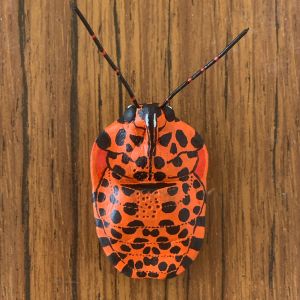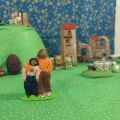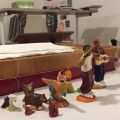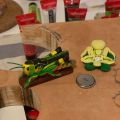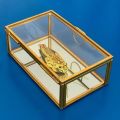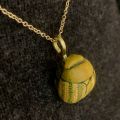Santons: People of the grass: Difference between revisions
| (33 intermediate revisions by the same user not shown) | |||
| Line 1: | Line 1: | ||
[[File:santons-divers-3.jpg|thumb|Upper part of the santon <i>Graphosoma italicum</i>, before being assembled with its legs.]] | |||
<i>Ongoing project written at first person as Robin Bantigny.</i> | |||
After moving to Provence, in Marseille, the [https://en.wikipedia.org/wiki/Santon_(figurine) Santons from Provence] quickly caught my attention with the Santons market in the Vieux port, which takes place in december. Well before Christmas 2022, my partner and I began building a secular nativity scene combining santons made by santonniers and santons made by me. The later represented wild animals (unlike the traditional domestic animals) and characters looking like my partner and I in a fantasy world. I quickly got caught up in this art form and added my mother and her dog, my brother, my father-in-law, my brother-in-law, my best friend, a couple of friends, my sister and her family, my cousin, etc. to the nativity scene. | |||
== | All these vernacular representations of loved ones served as gifts, and I hope to create an emotional connection to these “cute” figurines in their recipients. I would even be tempted to give them a magical dimension: they are closer to talismans and amulets <ref>Their paper packaging was also carefully designed, like the cases for amulets and other charms.</ref> than framed photographic portraits. | ||
This is how I came to want to transfer this “friendly” and magical quality to insects, a clade of living creatures that generally attracts disgust <ref>If we omit bees and ladybugs.</ref> and that could really use a boost in affection to survive the onslaught of human agribusiness. So, in a way, I gave insects a place in the sacred familiarity of the nativity scene by transforming them into Provençal santons. In doing so, I tried to remain as descriptive as possible of the species represented — within the limited scope of a few grams of clay and square centimeters of paint. | |||
=== Related images === | |||
<gallery mode="traditional"> | |||
File:santons-creche.jpg| | |||
File:santons-divers-1.jpg| | |||
File:santons-famille.jpg| | |||
File:santons-divers-2.jpg| | |||
File:santons-ecrin.jpg| | |||
File:santons-pendentif.jpg| | |||
</gallery> | |||
== Completed santons of arthropods’ species == | |||
{| class="wikitable" | {| class="wikitable" | ||
! French name | ! French name | ||
! English name | ! English name | ||
! Latin name | ! Latin name | ||
! style=min-width:590px | Pictures | ! style=min-width:590px | Pictures | ||
! About the species | ! style=min-width:150px | About the species | ||
|- | |- | ||
! Œdémère noble | ! Œdémère noble | ||
| False oil beetle || Oedemera nobilis || [[File:oedemera-nobilis_3wiki.jpg|398px]] [[File:oedemera-nobilis_3story.jpg|175px]] | | False oil beetle || [https://en.wikipedia.org/wiki/Oedemera_nobilis Oedemera nobilis] || [[File:oedemera-nobilis_3wiki.jpg|398px]] [[File:oedemera-nobilis_3story.jpg|175px]] | ||
|| The males of this green critter have such massive hind femoras that people call it a “maillot vert” (the green jersey is worn by the best sprinter during Tour de France). They are an important pollinator species all across Western Europe. | || The males of this green critter have such massive hind femoras that people call it a “maillot vert” (the green jersey is worn by the best sprinter during Tour de France). They are an important pollinator species all across Western Europe. | ||
|- | |- | ||
! Clyte trifascié | ! Clyte trifascié | ||
| Mediterranean Longhorn beetle || Chlorophorus trifasciatus || [[File:chlorophorus-trifasciatus_3wiki.jpg|398px]] [[File:chlorophorus-trifasciatus_3story.jpg|175px]] | | Mediterranean Longhorn beetle || [https://en.wikipedia.org/wiki/Chlorophorus_trifasciatus Chlorophorus trifasciatus] || [[File:chlorophorus-trifasciatus_3wiki.jpg|398px]] [[File:chlorophorus-trifasciatus_3story.jpg|175px]] | ||
|| Longhorn beetles are | || Longhorn beetles are essential pollinators: adults (<i>imagos</i>) often feed on plants’ nectar; while larvaes feed on wood (<i>xylophagous</i>). | ||
|- | |- | ||
! Empuse commune | ! Empuse commune | ||
| Conehead mantis || | | Conehead mantis || [https://en.wikipedia.org/wiki/Empusa_pennataEmpusa pennata] || [[File:empusa-pennata_3wiki.jpg|398px]] | ||
|| Contrary to praying mantis, females do not devour the male while reproducing. | || Contrary to praying mantis, females do not devour the male while reproducing. | ||
|- | |- | ||
! Gendarme | ! Gendarme | ||
| Firebug || Pyrrhocoris apterus || [[File:pyrrhocoris-apterus_3wiki.jpg|398px]] [[File:pyrrhocoris-apterus_3story.jpg|175px]] | | Firebug || [https://en.wikipedia.org/wiki/Pyrrhocoris_apterus Pyrrhocoris apterus] || [[File:pyrrhocoris-apterus_3wiki.jpg|398px]] [[File:pyrrhocoris-apterus_3story.jpg|175px]] | ||
|| These bugs are subordinate to lime trees and mallows. Their french name refers to the “gendarme”, a feared paramilitary force which XIXth century uniforms used to display the same colors as those bugs. | || These bugs are subordinate to lime trees and mallows. Their french name refers to the “gendarme”, a feared paramilitary force which XIXth century uniforms used to display the same colors as those bugs. | ||
|- | |- | ||
! Bupreste à neuf tâches | ! Bupreste à neuf tâches | ||
| Jewel beetle with nine spots || Buprestis novemmaculata || [[File:buprestis-novemmaculata_3wiki.jpg|398px]] [[File:buprestis-novemmaculata_3story.jpg|175px]] | | Jewel beetle with nine spots || [https://en.wikipedia.org/wiki/Buprestis Buprestis novemmaculata] || [[File:buprestis-novemmaculata_3wiki.jpg|398px]] [[File:buprestis-novemmaculata_3story.jpg|175px]] | ||
|| Adults feed on pollen while larvaes dig tunnels into pines’ wood. | || Adults feed on pollen while larvaes dig tunnels into pines’ wood. | ||
|- | |- | ||
! Perce-oreille commun | ! Perce-oreille commun | ||
| European earwing || Forticula auricularia || [[File:forticula-auricularia_3wiki.jpg|398px]] [[File:forticula-auricularia_3story.jpg|175px]] | | European earwing || [https://en.wikipedia.org/wiki/Forficula_auricularia Forticula auricularia] || [[File:forticula-auricularia_3wiki.jpg|398px]] [[File:forticula-auricularia_3story.jpg|175px]] | ||
|| There are many theories about their name origins: some say that it comes from the appearance of the hindwings, which are unique in their resemblance to human ears, other argue that they really used to be wore as earrings, but their forceps (<i>cerci</i>) are generally only used for courtship. | || There are many theories about their name origins: some say that it comes from the appearance of the hindwings, which are unique in their resemblance to human ears, other argue that they really used to be wore as earrings, but their forceps (<i>cerci</i>) are generally only used for courtship. | ||
|- | |- | ||
! Chrysomèle fastueuse | ! Chrysomèle fastueuse | ||
| Dead-nettle leaf beetle || Chrysolina fastuosa || [[File:chrysolina-fastuosa_3wiki.jpg|398px]] [[File:chrysolina-fastuosa_3story.jpg|175px]] | | Dead-nettle leaf beetle || [https://en.wikipedia.org/wiki/Fasta Chrysolina fastuosa] || [[File:chrysolina-fastuosa_3wiki.jpg|398px]] [[File:chrysolina-fastuosa_3story.jpg|175px]] | ||
|| This beautiful little bug is typically playing dead when found on a nettle or other Lamiaceae plants. | || This beautiful little bug is typically playing dead when found on a nettle or other Lamiaceae plants. | ||
|- | |- | ||
! Criquet bariolé | ! Criquet bariolé | ||
| Large banded grasshopper || Arcyptera fusca || [[File:arcyptera-fusca_3wiki.jpg|398px]] [[File:arcyptera-fusca_3story.jpg|175px]] | | Large banded grasshopper || [https://en.wikipedia.org/wiki/Arcyptera_fusca Arcyptera fusca] || [[File:arcyptera-fusca_3wiki.jpg|398px]] [[File:arcyptera-fusca_3story.jpg|175px]] | ||
|| | || Typical from dry meadows and high mountains, those grasshoppers have become scarce in Eastern Europe. | ||
|- | |- | ||
! Frelon d'Europe | ! Frelon d'Europe | ||
| European hornet || Vespa crabro || [[File:vespa-crabro_3wiki.jpg|398px]] [[File:vespa-crabro_3story.jpg|175px]] | | European hornet || [https://en.wikipedia.org/wiki/European_hornet Vespa crabro] || [[File:vespa-crabro_3wiki.jpg|398px]] [[File:vespa-crabro_3story.jpg|175px]] | ||
|| These are useful predator for the European ecosystems, and they are not worse/better than asian hornet, which has been in Europe for so long that it is part of it too. | || These are useful predator for the European ecosystems, and they are not worse/better than asian hornet, which has been in Europe for so long that it is part of it too. | ||
Only females possess a stinger, it is a modified egg laying device: males cannot sting. Colonies live in paper nests located in dark places, that are made by female workers’ cement: they chew bark and trees mixed with their saliva to build their home (like most social wasps). | Only females possess a stinger, it is a modified egg laying device: males cannot sting. Colonies live in paper nests located in dark places, that are made by female workers’ cement: they chew bark and trees mixed with their saliva to build their home (like most social wasps). | ||
|- | |- | ||
! Grande perle (nymphe) | ! Grande perle (nymphe) | ||
| Stonefly (nymph) || Perla bipunctata (naiad) || [[File:perla-bipunctata_3wiki.jpg|398px]] [[File:perla-bipunctata_3story.jpg|175px]] | | Stonefly (nymph) || [https://en.wikipedia.org/wiki/Perla_(stonefly) Perla bipunctata (naiad)] || [[File:perla-bipunctata_3wiki.jpg|398px]] [[File:perla-bipunctata_3story.jpg|175px]] | ||
|| This is a nymph (juvenile form) stonefly, which are believed to be one of the most primitive groups of winged insects. Finding these nymphs, called “naiads”, in water streams is an indicator of excellent water quality. | || This is a nymph (juvenile form) stonefly, which are believed to be one of the most primitive groups of winged insects. Finding these nymphs, called “naiads”, in water streams is an indicator of excellent water quality. | ||
|- | |- | ||
! | ! Pimélie | ||
| | | Darkling beetle || [https://en.wikipedia.org/wiki/Pimelia Pimelia bipunctata] || [[File:pimelia-bipunctata_3wiki.jpg|398px]] | ||
|| | || Most darkling beetles (tenebrionids) are cute plant scavengers. Pimelia bipunctata are capable of secreting a smelly red liquid when they feel threaten. | ||
|- | |- | ||
! | ! Barbitiste languedocien (mâle) | ||
| | | Languedocian bush cricket (male) || [https://en.wikipedia.org/wiki/Barbitistes_fischeri Barbitistes fischeri] || [[File:barbitistes-fischeri_3wiki.jpg|398px]] [[File:barbitistes-fischeri_3story.jpg|175px]] | ||
|| | || | ||
|- | |- | ||
! | ! Hanneton commun | ||
| | | Common cockchafer || [https://en.wikipedia.org/wiki/Cockchafer#Taxonomy Melolontha melolontha] || [[File:melolontha-melolontha_3wiki.jpg|398px]] [[File:melolontha-melolontha_3story.jpg|175px]] | ||
|| As they multiply, cockchafers can become a farmers’ nightmare, eating plants’ roots unnoticed. Their life cycle is 3 years long, spent mostly buried in the soil. | |||
|| | |||
|} | |} | ||
== Modeling technique == | == Modeling technique == | ||
[[File:creche-provencale.jpg|thumb|Typical nativity scene depicted with Santons from Provence.]] | |||
[[File:santons_process-5.jpg|thumb|Fabrication of the molds for stincky bug species.]] | |||
[https://en.wikipedia.org/wiki/Santon_(figurine) Santons from Provence] are small, colorful clay figurines that represent the Nativity scene in Christmas cribs (the baby Jesus, the Virgin Mary, and Saint Joseph, with the donkey and ox supposed to warm the child with their breath), the Three Wise Men and the shepherds, as well as a whole series of small figures representing the inhabitants of a Provençal village and their traditional trades. | |||
The technique I used to make the insect santons is close to the same as that used for traditional Santons<ref>Santon makers go through seven stages to make a santon. First, they make a model out of raw clay placed on a base that will form part of the figure. Next, they make a plaster mold. The molding is done by pressing a coil of fresh clay into one half of the mold, which has been dusted with talcum powder. After pressing both sides by hand, the excess is trimmed away and the santon is removed from the mold and left to dry. The final manual operation consists of more precise trimming to remove all traces of the mold. The santon is then left to dry again before being fired in a kiln at 800°C. The final step is decoration, which is always done by hand.</ref>, but there are no molds nor firing: for now they are unique pieces that are sculpted and painted by hand. | |||
In the purpose of a small-scale mass production to use those figurines as a pedagogical tool for entomology initiation, I am now experimenting on molding: plaster molds are not flexible enough for the level of details of arthropods’ anatomy, thus I am working on latex molds to make plaster copies that would be light, robust and convenient to paint by hand. | |||
=== Pictures of the modeling techniques === | |||
. | <gallery mode="traditional"> | ||
File:santons_process-1.jpg| | |||
. | File:santons_process-2.jpg| | ||
File:santons_process-3.jpg| | |||
. | File:santons_process-4.jpg| | ||
</gallery> | |||
. | |||
== Sources == | |||
📷 Main sources for species and pictures: | |||
**Gwenole Le Guellec , <i>[https://www.lalibrairie.com/livres/insectes-de-mediterranee--arachnides-et-myriapodes_0-440669_9782744907616.html Insectes de Méditerranée: Arachnides et Myriapodes]</i>, Nature au Sud, France, 2008. | |||
**Helgard Reichholf-Riehm, <i>[https://www.le-livre.fr/livres/fiche-r300270329.html Les insectes]</i>, La nature en couleurs, France Loisirs, France 1994, Allemagne 1983. | |||
== Notes == | |||
Latest revision as of 19:39, 13 September 2025
Ongoing project written at first person as Robin Bantigny.
After moving to Provence, in Marseille, the Santons from Provence quickly caught my attention with the Santons market in the Vieux port, which takes place in december. Well before Christmas 2022, my partner and I began building a secular nativity scene combining santons made by santonniers and santons made by me. The later represented wild animals (unlike the traditional domestic animals) and characters looking like my partner and I in a fantasy world. I quickly got caught up in this art form and added my mother and her dog, my brother, my father-in-law, my brother-in-law, my best friend, a couple of friends, my sister and her family, my cousin, etc. to the nativity scene.
All these vernacular representations of loved ones served as gifts, and I hope to create an emotional connection to these “cute” figurines in their recipients. I would even be tempted to give them a magical dimension: they are closer to talismans and amulets [1] than framed photographic portraits.
This is how I came to want to transfer this “friendly” and magical quality to insects, a clade of living creatures that generally attracts disgust [2] and that could really use a boost in affection to survive the onslaught of human agribusiness. So, in a way, I gave insects a place in the sacred familiarity of the nativity scene by transforming them into Provençal santons. In doing so, I tried to remain as descriptive as possible of the species represented — within the limited scope of a few grams of clay and square centimeters of paint.
Related images
Completed santons of arthropods’ species
| French name | English name | Latin name | Pictures | About the species |
|---|---|---|---|---|
| Œdémère noble | False oil beetle | Oedemera nobilis | The males of this green critter have such massive hind femoras that people call it a “maillot vert” (the green jersey is worn by the best sprinter during Tour de France). They are an important pollinator species all across Western Europe. | |
| Clyte trifascié | Mediterranean Longhorn beetle | Chlorophorus trifasciatus | Longhorn beetles are essential pollinators: adults (imagos) often feed on plants’ nectar; while larvaes feed on wood (xylophagous). | |
| Empuse commune | Conehead mantis | pennata | Contrary to praying mantis, females do not devour the male while reproducing. | |
| Gendarme | Firebug | Pyrrhocoris apterus | These bugs are subordinate to lime trees and mallows. Their french name refers to the “gendarme”, a feared paramilitary force which XIXth century uniforms used to display the same colors as those bugs. | |
| Bupreste à neuf tâches | Jewel beetle with nine spots | Buprestis novemmaculata | Adults feed on pollen while larvaes dig tunnels into pines’ wood. | |
| Perce-oreille commun | European earwing | Forticula auricularia | There are many theories about their name origins: some say that it comes from the appearance of the hindwings, which are unique in their resemblance to human ears, other argue that they really used to be wore as earrings, but their forceps (cerci) are generally only used for courtship. | |
| Chrysomèle fastueuse | Dead-nettle leaf beetle | Chrysolina fastuosa | This beautiful little bug is typically playing dead when found on a nettle or other Lamiaceae plants. | |
| Criquet bariolé | Large banded grasshopper | Arcyptera fusca | Typical from dry meadows and high mountains, those grasshoppers have become scarce in Eastern Europe. | |
| Frelon d'Europe | European hornet | Vespa crabro | These are useful predator for the European ecosystems, and they are not worse/better than asian hornet, which has been in Europe for so long that it is part of it too.
Only females possess a stinger, it is a modified egg laying device: males cannot sting. Colonies live in paper nests located in dark places, that are made by female workers’ cement: they chew bark and trees mixed with their saliva to build their home (like most social wasps). | |
| Grande perle (nymphe) | Stonefly (nymph) | Perla bipunctata (naiad) | This is a nymph (juvenile form) stonefly, which are believed to be one of the most primitive groups of winged insects. Finding these nymphs, called “naiads”, in water streams is an indicator of excellent water quality. | |
| Pimélie | Darkling beetle | Pimelia bipunctata | Most darkling beetles (tenebrionids) are cute plant scavengers. Pimelia bipunctata are capable of secreting a smelly red liquid when they feel threaten. | |
| Barbitiste languedocien (mâle) | Languedocian bush cricket (male) | Barbitistes fischeri | ||
| Hanneton commun | Common cockchafer | Melolontha melolontha | As they multiply, cockchafers can become a farmers’ nightmare, eating plants’ roots unnoticed. Their life cycle is 3 years long, spent mostly buried in the soil. |
Modeling technique
Santons from Provence are small, colorful clay figurines that represent the Nativity scene in Christmas cribs (the baby Jesus, the Virgin Mary, and Saint Joseph, with the donkey and ox supposed to warm the child with their breath), the Three Wise Men and the shepherds, as well as a whole series of small figures representing the inhabitants of a Provençal village and their traditional trades.
The technique I used to make the insect santons is close to the same as that used for traditional Santons[3], but there are no molds nor firing: for now they are unique pieces that are sculpted and painted by hand.
In the purpose of a small-scale mass production to use those figurines as a pedagogical tool for entomology initiation, I am now experimenting on molding: plaster molds are not flexible enough for the level of details of arthropods’ anatomy, thus I am working on latex molds to make plaster copies that would be light, robust and convenient to paint by hand.
Pictures of the modeling techniques
Sources
📷 Main sources for species and pictures:
- Gwenole Le Guellec , Insectes de Méditerranée: Arachnides et Myriapodes, Nature au Sud, France, 2008.
- Helgard Reichholf-Riehm, Les insectes, La nature en couleurs, France Loisirs, France 1994, Allemagne 1983.
Notes
- ↑ Their paper packaging was also carefully designed, like the cases for amulets and other charms.
- ↑ If we omit bees and ladybugs.
- ↑ Santon makers go through seven stages to make a santon. First, they make a model out of raw clay placed on a base that will form part of the figure. Next, they make a plaster mold. The molding is done by pressing a coil of fresh clay into one half of the mold, which has been dusted with talcum powder. After pressing both sides by hand, the excess is trimmed away and the santon is removed from the mold and left to dry. The final manual operation consists of more precise trimming to remove all traces of the mold. The santon is then left to dry again before being fired in a kiln at 800°C. The final step is decoration, which is always done by hand.
